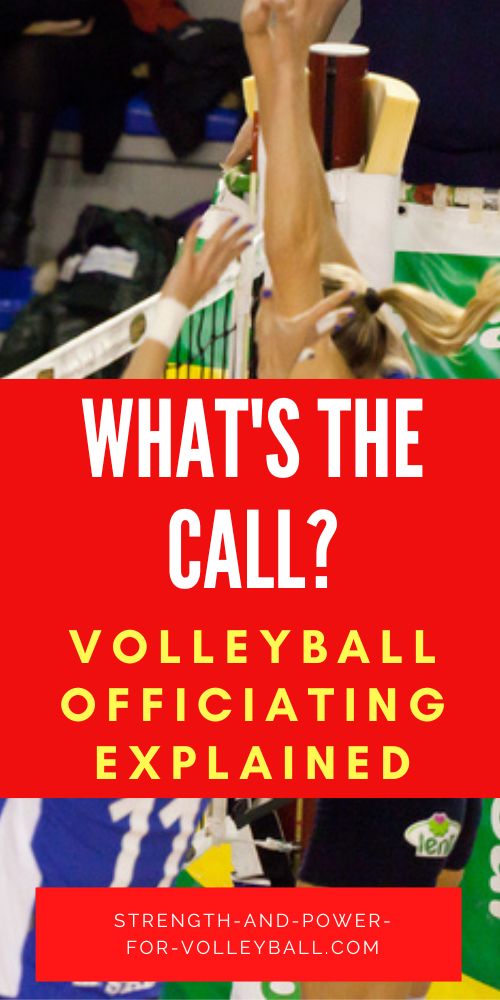Calls in Volleyball
Referee Signals and Calls
Calls in volleyball. Learn what the referee is calling.
Hand Signals - Calls in Volleyball
Authorization to Serve
The referee makes this signal to beckon the server. The referee indicates the direction to serve. The server then serves the ball.
Team to Serve
This is the signal to indicate which team is serving next.
Change of Courts
This is the signal for teams to change sides of the court.
Time-out
This the time-out signal.
Substitution
Signal for substitution.
Misconduct Warning
Show yellow card for a warning.
Misconduct Penalty
Show a red card for a penalty.
Expulsion
Show both cards for an expulsion.
Disqualification
Both cards are shown for a disqualification.
End of Set
This is the end of set or end of match signal.
Ball Not Tossed or Released for the Service
Delay in Service
Called when the server doesn't serve the ball in the allotted time.
Blocking Fault
This signal is for an illegal block. There are situations where it's not legal for a player to block a ball. For example, a back row player can't legally complete a block. Only front row players are allowed to block.
Screening
Signal for an illegal screen. Screening isn't called very often. Usually, the referee will issue a verbal warning before calling a screen.
Positional or Rotational Fault
Out of rotation signal. It's at the moment of contact for serve the players need to be in the correct position on the court.
Common Signals - Calls in Volleyball
Ball "in"
The signal made when the ball lands "inside" the court.
Ball "out"
The signal made when the ball lands "outside" the court. If the ball hits any object outside the court, the ball is out of play.
Catch
A catch is when the ball is illegal caught.
Double Contact
A double contact is when a player illegally double contacts the ball.
Four Hits
Four hits is when a team contacts the ball four times. A team only gets a maximum a three contacts before the ball must be sent over the net to the opponent.
Net Touched By Player
The referee blows the whistle and signals a net violation on a player that touches the net illegally.
Served Ball Doesn't Pass Vertical Plane of Net
This is the signal for when the ball fails to break the vertical plane of the net.
Different Calls in Volleyball
Reaching Beyond the Net
The is the signal for a player reaching over the net and contact the ball.
Attack Hit Fault
This is the signal for an illegal attack hit.
Penetration into the Opponent Court
This is the signal for a player illegally penetrating into the opponents court.
Line Fault
This is the signal for a line violation.
Double Fault
The is a double fault that results in a play-over.
Replay
This is the replay signal.
Ball Touched
This is the touch signal. This signal is used when the ball is touched and lands out of play. If the ball is touch then lands in the court, the correct signal is to signal the ball "in".
Delay Warning
The delay warning is done by placing a yellow card against the wrist. A yellow card is a point for the opponent.
Delay Penalty
The delay warning is done by placing a red card against the wrist.
Illegal Contact
This is the signal used in coed for when 2 males send the ball over the net without a female contacting the ball.
Line Judge Signals
Ball "in"
The ball is "in" whenever the ball lands on a boundary line or within the court space.
Ball "out"
The ball is "out" whenever the ball makes contact with the space outside the boundary line. The ball is also out of play if contact is made with any object outside the court. This includes the antenna, the netting outside the antenna, the poles or cables supporting the net.
Ball Touched
The line judge signals a "touch" when the ball is touched by a player and the ball lands out of play.
Crossing Space Faults
The line judge signals "out" when the ball crosses the antenna outside the court. There are certain organizations where the "pursuit rule" is in effect. Pursuit is when a player retrieves a ball by pursing it outside the antenna. This would be on a poorly passed ball that crosses outside the antenna. A teammate runs down the ball and sends the ball back in the court where a third contact is made to send the ball back over the net.
Ball Touched Outside Object
The line judge signals "out" when the ball is touched by an object that's out of play.
Foot Fault
The line judge signals "foot fault" by raising the flag and pointing with the finger to the line when a player commits a foot fault while serving.
Judgement Impossible
The line judge crosses the arms when they line judge is unable to make a call.
If you enjoyed these tips for making calls in volleyball and would like to keep them close to you at any time, just save this pin to your Pinterest Volleyball Training Board.
